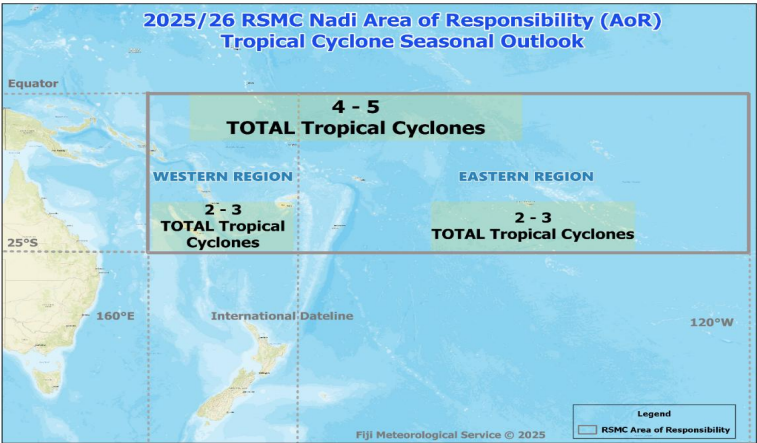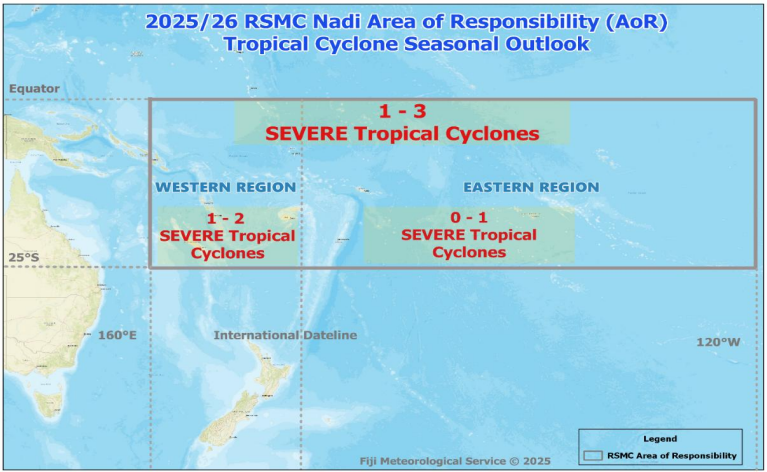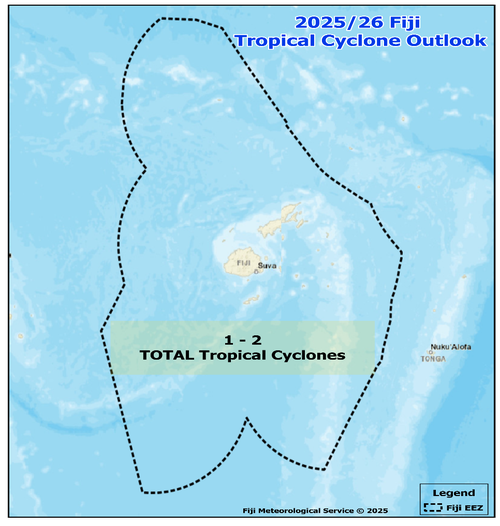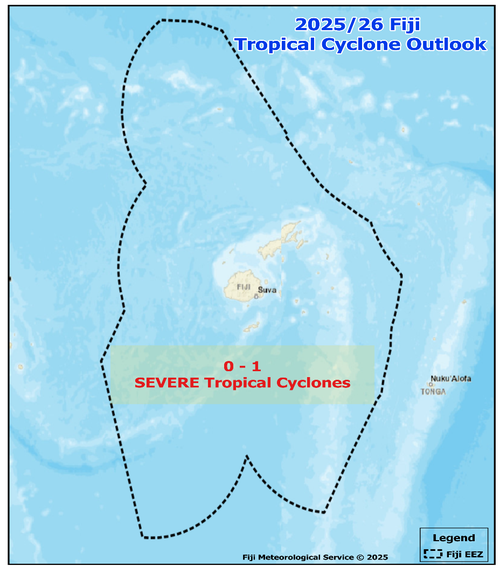Tropical Cyclone Outlook
RSMC Nadi
RSMC Nadi
Key Messages
- Four to five Tropical Cyclones (TCs) are likely in the Regional Specialized Meteorological Center Nadi-Tropical Cyclone Center (RSMC Nadi-TCC) Area of Responsibility (AoR) between November 2025 to April 2026.
- On average, around seven TCs affect the RSMC Nadi-TCC AoR in a season. Thus, this season is predicted to have below-average TC activity.
- Around four TCs per season on average affect west of the Dateline in the RSMC-Nadi TCC AoR, and around four to the east. This season, two to three TCs are likely to affect west of the Dateline, which means near average or below average TC risk. To the east, two to three TCs are likely, which is a near average risk.
- Three severe TCs, that is, Category 3 or higher intensity, on average affect the RSMC NadiTCC AoR a season. This season is likely to have one to three severe TCs, which is a near-average or below-average risk.
- One to two severe (1-2) TCs are likely to the west of Dateline (long-term average is 2), which is near average risk. On the other hand, zero to one (0-1) severe TCs are likely to the east of the Dateline (long-term average is 2), which is a below average risk.
- While the TC season in the region is between November and April, occasionally cyclones have formed in October and May, and rarely in September and June. Therefore, out-of-season TCs cannot be ruled out.
- The peak TC season in the RMSC-Nadi TCC AoR is usually between January to February, but TCs can form at any time throughout the season.

Figure 1: Total number of TCs forecasted for the RSMC Nadi-TCC AoR.

Figure 2: Number of severe TCs forecasted for the RSMC Nadi-TCC AoR.
Additional Information
- TC activities in the Pacific Island region are closely associated with the El Niño Southern Oscillation (ENSO), which is a fluctuation of oceanic and atmospheric condition between the eastern and western tropical Pacific Ocean.
- ENSO neutral condition currently persists, with models favoring a weak La Niña to be established within the tropical Pacific in the coming months, with chances of a return to ENSOneutral during the beginning of 2026.
- To predict the outlook for the 2025-26 TC season, analogue seasons were identified, that is, seasons in the past (from 1980) with similar background climate. These seasons were 1980-81, 1983-84, 2000-01, 2001-02, 2003-04, 2005-06, 2012-13, 2016-17.
- The TCs season in the southwest Pacific extend from November to April, with the peak TC activities normally experienced from January to March. However, TCs have occasionally occurred in this region during October and May, and rarely in September and June. One of the analogue seasons (2016-17) also had an out of season TC. Thus, out of season TCs cannot be ruled out.
- Tropical disturbances or depressions that do not attain TC intensity can also cause strong winds/gusts, widespread rainfall, landslides and flooding.
- Please contact the respective Pacific Island National Meteorological Service for detailed national level information.
RSMC Nadi
RSMC Nadi
Key Messages
- Four to five Tropical Cyclones (TCs) are likely in the Regional Specialized Meteorological Center Nadi-Tropical Cyclone Center (RSMC Nadi-TCC) Area of Responsibility (AoR) between November 2025 to April 2026.
- On average, around seven TCs affect the RSMC Nadi-TCC AoR in a season. Thus, this season is predicted to have below-average TC activity.
- Around four TCs per season on average affect west of the Dateline in the RSMC-Nadi TCC AoR, and around four to the east. This season, two to three TCs are likely to affect west of the Dateline, which means near average or below average TC risk. To the east, two to three TCs are likely, which is a near average risk.
- Three severe TCs, that is, Category 3 or higher intensity, on average affect the RSMC NadiTCC AoR a season. This season is likely to have one to three severe TCs, which is a near-average or below-average risk.
- One to two severe (1-2) TCs are likely to the west of Dateline (long-term average is 2), which is near average risk. On the other hand, zero to one (0-1) severe TCs are likely to the east of the Dateline (long-term average is 2), which is a below average risk.
- While the TC season in the region is between November and April, occasionally cyclones have formed in October and May, and rarely in September and June. Therefore, out-of-season TCs cannot be ruled out.
- The peak TC season in the RMSC-Nadi TCC AoR is usually between January to February, but TCs can form at any time throughout the season.

Figure 1: Total number of TCs forecasted for the RSMC Nadi-TCC AoR.

Figure 2: Number of severe TCs forecasted for the RSMC Nadi-TCC AoR.
Additional Information
- TC activities in the Pacific Island region are closely associated with the El Niño Southern Oscillation (ENSO), which is a fluctuation of oceanic and atmospheric condition between the eastern and western tropical Pacific Ocean.
- ENSO neutral condition currently persists, with models favoring a weak La Niña to be established within the tropical Pacific in the coming months, with chances of a return to ENSOneutral during the beginning of 2026.
- To predict the outlook for the 2025-26 TC season, analogue seasons were identified, that is, seasons in the past (from 1980) with similar background climate. These seasons were 1980-81, 1983-84, 2000-01, 2001-02, 2003-04, 2005-06, 2012-13, 2016-17.
- The TCs season in the southwest Pacific extend from November to April, with the peak TC activities normally experienced from January to March. However, TCs have occasionally occurred in this region during October and May, and rarely in September and June. One of the analogue seasons (2016-17) also had an out of season TC. Thus, out of season TCs cannot be ruled out.
- Tropical disturbances or depressions that do not attain TC intensity can also cause strong winds/gusts, widespread rainfall, landslides and flooding.
- Please contact the respective Pacific Island National Meteorological Service for detailed national level information.
Fiji
Key Messages
- One to two tropical cyclones (TCs) are likely to pass through Fiji’s Exclusive Economic Zone during the 2025-26 TC season.
- Of these, one TC is likely to reach severe Category (Category 3-5).
- There is an equal risk of TCs affecting any part of the Fiji Group.
- While the peak TC activities are usually from January to February, TCs can form at any time during the season. Out-of-season TCs cannot be ruled out.
- It does not take a direct hit or a severe TC to cause considerable damage or life-threatening weather. Tropical disturbances or depressions that do not attain TC intensity can and have previously caused strong winds/gusts, widespread heavy rainfall, landslides, and flooding.
- All communities should remain alert and prepared throughout the TC season and take heed of all advisories whenever it is issued.

Figure 1: Total number of TCs forecasted for the Fiji region.

Figure 2. Number of severe TCs forecasted for the Fiji region.
Additional Information
- To generate the outlook for the 2025-26 TC season, analogous seasons were identified, that is, seasons in the past (from 1980) with similar background climate. These seasons were 1980/81, 1983/84, 2000/01, 2001/02, 2003/04, 2005/06, 2012/13, and 2016/17.
- On average, around two TCs affect Fiji every season. Thus, near normal tropical cyclone activity is likely for the Fiji region this season.
- The TC season in the southwest Pacific extend from November to April, with the peak TC activities normally experienced from January to March. However, TCs have occasionally occurred in this region during October and May, and rarely in September and June. Out of season TCs cannot be ruled out this season.
- In the past, tropical depressions also had significant impact on Fiji, especially heavy rainfall and severe flooding. Thus, it is important to take heed of all-weather advisories seriously.
Detailed Outlook
January 14, 2025